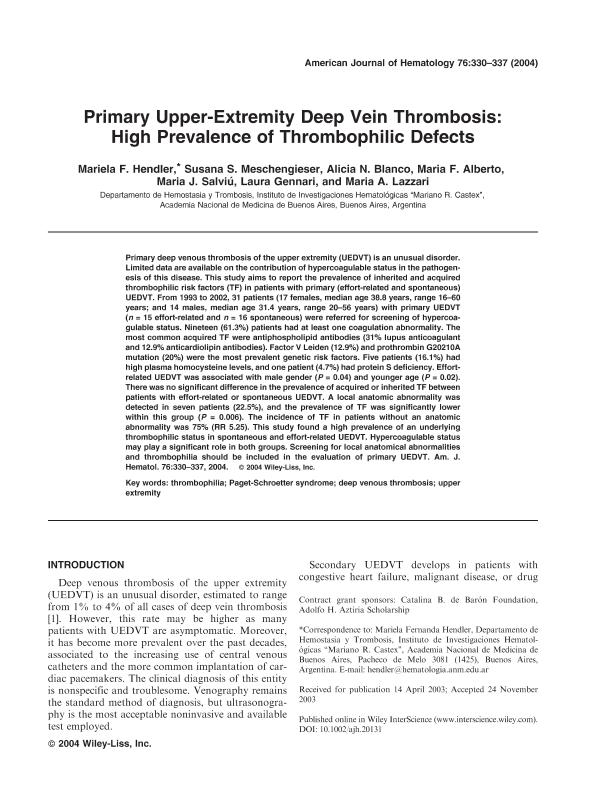Artículo
Primary upper-extremity deep vein thrombosis: High prevalence of thrombophilic defects
Hendler, Mariela F.; Meschengieser, Susana S.; Blanco, Alicia Noemi; Alberto, Maria Fabiana; Salviú, Maria J.; Gennari, Laura; Lazzari, María Ángela

Fecha de publicación:
08/2004
Editorial:
Wiley-liss, Div John Wiley & Sons Inc
Revista:
American Journal Of Hematology
ISSN:
0361-8609
Idioma:
Inglés
Tipo de recurso:
Artículo publicado
Clasificación temática:
Resumen
Primary deep venous thrombosis of the upper extremity (UEDVT) is an unusual disorder. Limited data are available on the contribution of hypercoagulable status in the pathogenesis of this disease. This study aims to report the prevalence of inherited and acquired thrombophilic risk factors (TF) in patients with primary (effort-related and spontaneous) UEDVT. From 1993 to 2002, 31 patients (17 females, median age 38.8 years, range 16-60 years; and 14 males, median age 31.4 years, range 20-56 years) with primary UEDVT (n = 15 effort-related and n = 16 spontaneous) were referred for screening of hypercoagulable status. Nineteen (61.3%) patients had at least one coagulation abnormality. The most common acquired TF were antiphospholipid antibodies (31% lupus anticoagulant and 12.9% anticardiolipin antibodies). Factor V Leiden (12.9%) and prothrombin G20210A mutation (20%) were the most prevalent genetic risk factors. Five patients (16.1%) had high plasma homocysteine levels, and one patient (4.7%) had protein S deficiency. Effort-related UEDVT was associated with male gender (P = 0.04) and younger age (P = 0.02). There was no significant difference in the prevalence of acquired or inherited TF between patients with effort-related or spontaneous UEDVT. A local anatomic abnormality was detected in seven patients (22.5%), and the prevalence of TF was significantly lower within this group (P = 0.006). The incidence of TF in patients without an anatomic abnormality was 75% (RR 5.25). This study found a high prevalence of an underlying thrombophilic status in spontaneous and effort-related UEDVT. Hypercoagulable status may play a significant role in both groups. Screening for local anatomical abnormalities and thrombophilia should be included in the evaluation of primary UEDVT.
Archivos asociados
Licencia
Identificadores
Colecciones
Articulos(IMEX)
Articulos de INST.DE MEDICINA EXPERIMENTAL
Articulos de INST.DE MEDICINA EXPERIMENTAL
Citación
Hendler, Mariela F.; Meschengieser, Susana S.; Blanco, Alicia Noemi; Alberto, Maria Fabiana; Salviú, Maria J.; et al.; Primary upper-extremity deep vein thrombosis: High prevalence of thrombophilic defects; Wiley-liss, Div John Wiley & Sons Inc; American Journal Of Hematology; 76; 4; 8-2004; 330-337
Compartir
Altmétricas



